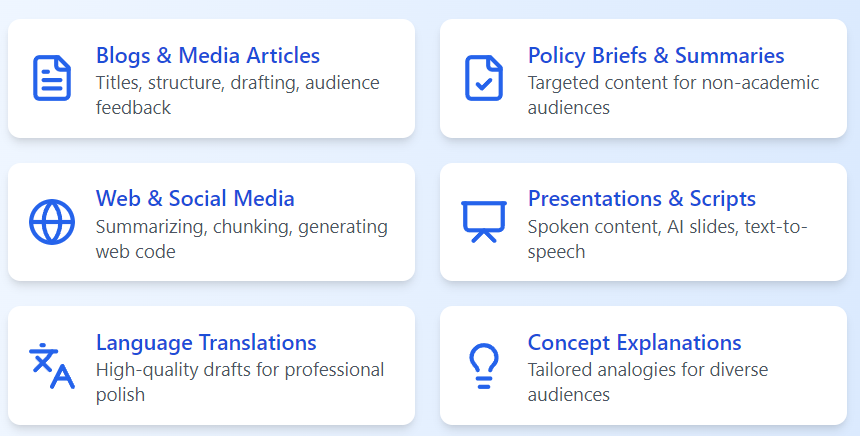Benefits for Knowledge Exchange and Impact (KEI)
It’s an unfortunate fact that much of academic writing is inaccessible for the vast majority of the human population. The accusation of ‘ivory tower academics’ may be exaggerated but it’s not unreasonable. It’s moreover forgivable, since career progression incentives overwhelmingly steer academics towards working at the cutting edge of narrow research fields where the quality of written output is judged by a niche audience of expert academic peers. It takes a lot of effort, linguistic skill and objective detachment to communicate the complexities and value of advanced research to non-expert audiences effectively.
Generative AI brings enormous potential for KEI because language tasks (as opposed to generating factual information) are what the technology excels at. As of Summer 2024 the most advanced LLMs are GPT4, Claude 3 Opus and Claure 3.5 Sonnet and these models are already extremely capable when it comes to language transformations. While they’re a long way from being able to generate polished outputs, they can save a huge amount of time and effort and occasionally provide novel communication solutions that may not have occurred to a researcher who has been deeply involved in their narrow topic for so long. GPT4/o and Claude 3/3.5 can at present comfortably digest a full academic paper within their context window (aka ‘conversational memory’) – note as always any copyright limitations for academic texts, even for licensed works available at LSE, because some publishers forbid sharing their texts with commercial GAI tools particularly where the T&Cs reference using uploaded data for training future models. If in doubt, always use Microsoft Copilot with your LSE login as your inputs or data never get stored.
Anybody who has tried to use LLMs to write academic work has inevitably been disappointed at the ‘blog-tier’ style it tends to default to, which in large part is due to the dominance of public web text that the LLMs have been trained on, which tend to be written for broad audiences. This makes LLMs – at the moment - terrible for quality academic writing but a godsend for any kind of accessibly communicated transformation of academic content for wider audiences. And moreover it can generate and re-generate quickly without ever getting tired or bored – KEI activities are generally not that difficult but they can be very daunting to get started on and dedicate the time to work on when there are so many other pressures. There are myriad options to take advantage of LLM capabilities to enhance KEI:

More detailed examples:
- Blogs or general interest media articles
Title, keywords, captions, structure plan, drafting, feedback on wording and style to suit particular audiences, suggesting counter-examples or critiques from multiple fictional personas, generating visuals (primarily artistic – some limited code-based diagrams are possible if there's a code scheme for the design, e.g. Mermaid diagrams)
- Policy Briefs or Executive Summaries for government, business or other non-academic organisations
As per the blog example but stylistically targeted towards a particular specified audience.
- Web pages, newsletters, FAQs, social media posts
Condensing, summarising and captioning long form content into bite-sized sections and chunks, e.g. tweets and tweet threads. In addition LLMs are very capable at producing viable, aesthetically appealing HTML, CSS and Javascript (for interactivity) web pages from natural language prompts without any programming background, if that’s something that’s desired.
- Presentation / debate / interview / video scripts – including high quality AI text to speech
Similar to web / social media summarising but explicitly designed for spoken word communications. There are even tools like Copilot for Microsoft 365 that can generate a decent first draft PowerPoint presentation – including intelligent artistic visuals – from a source document, though as of April 2024 this isn’t available to educational organisations yet. ElevenLabs is the current leader in realistic text to speech generation which is great for explainer videos; Open AI has announced in April 2024 what seems like an even more impressive text to speech model but not available for public consumption yet.
GPT4 (and the o1 models) and the Claude 3/3.5 models are very impressive at long form translations into different languages, orders of magnitude superior to common tools like Google Translate. While they can't compete with the best professional human translators (and some languages are more present in the training data than others), the outputs can be good quality drafts sent to professional translators for polishing which can save a significant amount of time and money.
- Concept explanations for different audiences
Without even drafting content, asking an advanced LLM to explain particular concepts from your research to a particular audience persona – using not only language but analogies that might be easier for that audience to grasp – can be a huge help not just for a specific task but for taking a new perspective on your own work.